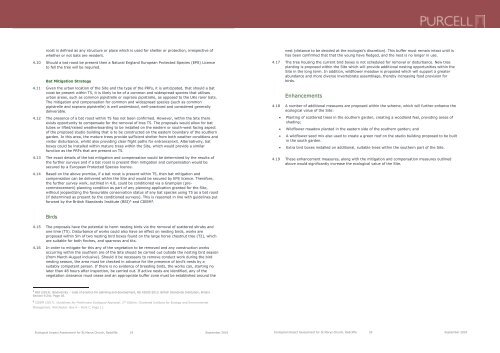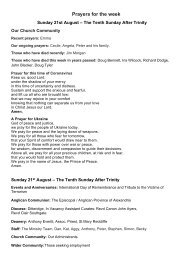St Mary Redcliffe Project 450 RIBA 2 Stage End Report
Create successful ePaper yourself
Turn your PDF publications into a flip-book with our unique Google optimized e-Paper software.
oost is defined as any structure or place which is used for shelter or protection, irrespective of<br />
whether or not bats are resident.<br />
4.10 Should a bat roost be present then a Natural England European Protected Species (EPS) Licence<br />
to fell the tree will be required.<br />
Bat Mitigation <strong>St</strong>rategy<br />
4.11 Given the urban location of the Site and the type of the PRFs, it is anticipated, that should a bat<br />
roost be present within T5, it is likely to be of a common and widespread species that utilises<br />
urban areas, such as common pipistrelle or soprano pipistrelle, as opposed to the UKs rarer bats.<br />
The mitigation and compensation for common and widespread species (such as common<br />
pipistrelle and soprano pipistrelle) is well understood, well-practiced and considered generally<br />
deliverable.<br />
4.12 The presence of a bat roost within T5 has not been confirmed. However, within the Site there<br />
exists opportunity to compensate for the removal of tree T5. The proposals would allow for bat<br />
tubes or lifted/raised weatherboarding to be installed on the eastern or south-west facing aspect<br />
of the proposed studio building that is to be constructed on the eastern boundary of the southern<br />
garden. In this area, the mature trees provide sufficient shelter from both weather conditions and<br />
visitor disturbance, whilst also providing clear flight paths for entrance/exit. Alternatively, bat<br />
boxes could be installed within mature trees within the Site, which would provide a similar<br />
function as the PRFs that are present on T5.<br />
4.13 The exact details of the bat mitigation and compensation would be determined by the results of<br />
the further surveys and if a bat roost is present then mitigation and compensation would be<br />
secured by a European Protected Species licence.<br />
nest (distance to be decided at the ecologist's discretion). This buffer must remain intact until is<br />
has been confirmed that that the young have fledged, and the nest is no longer in use.<br />
4.17 The tree housing the current bird boxes is not scheduled for removal or disturbance. New tree<br />
planting is proposed within the Site which will provide additional nesting opportunities within the<br />
Site in the long term. In addition, wildflower meadow is proposed which will support a greater<br />
abundance and more diverse invertebrate assemblage, thereby increasing food provision for<br />
birds.<br />
Enhancements<br />
4.18 A number of additional measures are proposed within the scheme, which will further enhance the<br />
ecological value of the Site:<br />
• Planting of scattered trees in the southern garden, creating a woodland feel, providing areas of<br />
shading;<br />
• Wildflower meadow planted in the eastern side of the southern garden; and<br />
• A wildflower seed mix also used to create a green roof on the studio building proposed to be built<br />
in the south garden.<br />
• Extra bird boxes installed on additional, suitable trees within the southern part of the Site.<br />
4.19 These enhancement measures, along with the mitigation and compensation measures outlined<br />
above would significantly increase the ecological value of the Site.<br />
4.14 Based on the above premise, if a bat roost is present within T5, then bat mitigation and<br />
compensation can be delivered within the Site and would be secured by EPS licence. Therefore,<br />
the further survey work, outlined in 4.8, could be conditioned via a Grampian (precommencement)<br />
planning condition as part of any planning application granted for the Site,<br />
without jeopardizing the favourable conservation status of any bat species using T5 as a bat roost<br />
(if determined as present by the conditioned surveys). This is reasoned in line with guidelines put<br />
forward by the British <strong>St</strong>andards Institute (BSI) 5 and CIEEM 6 .<br />
Birds<br />
4.15 The proposals have the potential to harm nesting birds via the removal of scattered shrubs and<br />
one lime (T5). Disturbance of works could also have an effect on nesting birds, works are<br />
proposed within 5m of two nesting bird boxes found on the large horse chestnut tree (T2), which<br />
are suitable for both finches, and sparrows and tits.<br />
4.16 In order to mitigate for this any of the vegetation to be removed and any construction works<br />
occurring within the southern are of the Site should be carried out outside the nesting bird season<br />
(from March-August inclusive). Should it be necessary to remove conduct work during the bird<br />
nesting season, the area must be checked in advance for the presence of bird's nests by a<br />
suitably competent person. If there is no evidence of breeding birds, the works can, starting no<br />
later than 48 hours after inspection, be carried out. If active nests are identified, any of the<br />
vegetation clearance must cease and an appropriate buffer zone must be established around the<br />
5 BSI (2013). Biodiversity – code of practice for planning and development, BS 42020:2013. British <strong>St</strong>andards Institution, Bristol.<br />
Section 9.24c. Page 36.<br />
6 CIEEM (2017). Guidelines for Preliminary Ecological Appraisal. 2<br />
nd<br />
Edition. Chartered Institute for Ecology and Environmental<br />
Management, Winchester. Box 4 – Point C. Page 11.<br />
Ecological Impact Assessment for <strong>St</strong>.<strong>Mary</strong>s Church, <strong>Redcliffe</strong> 19 September 2019<br />
Ecological Impact Assessment for <strong>St</strong>.<strong>Mary</strong>s Church, <strong>Redcliffe</strong> 20 September 2019


















